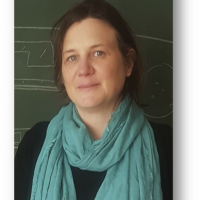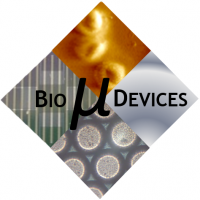Interpretating the sensor signal of a bioassay considering hydrodynamics (bias) in two classical configurations
Marie-Caroline Jullien, CNRS DR, Institut de Physique de Rennes/ENS-Rennes.
In a first configuration, the "classical" advection-diffusion laws rationalized by Squires et al [Making it stick: convection, reaction and diffusion in surface-based biosensors. Nat Biotechnol 26:417 (2008)] for molecules no longer work when functionalized nanoparticles are used. The difference between these two configurations comes from inertial forces that can appear even at low Reynolds number. We show that taking these forces into account allows us to determine the concentration profile of the particles in a channel cross-section and to reproduce the capture results observed experimentally. In a second configuration we address the complexation kinetics between two molecules which is generally obtained by performing so-called Langmuir isotherms. These isotherms generally require a non-negligible sample volume which can be critical if such molecules are available in low quantities. We propose to take advantage of the properties of the flows, the Taylor-Aris dispersion here, to produce non-equilibrium measurements. In the end, a reliable measurement is obtained with a reduction of 2 orders of magnitude on the necessary quantity.
References:
Influence of lift forces on particle capture on a functionalized surface, D Mottin, F Razan, F Kanoufi, MC Jullien, Microfluidics and Nanofluidics 25 (11), 1-10 (2021)
Out-of-Equilibrium Measurements of Kinetic Constants on a Biosensor, D Mottin, F Razan, C Nogues, MC Jullien, Analytical Chemistry 93 (19), 7266-7274 (2021)
Short biography :

Marie-Caroline Jullien a fait sa thèse sur la dispersion de traceurs dans des expériences de turbulence bidimensionnelle à l'ENS à Paris. Elle a ensuite fait un post-doc sur la cavitation à l'Université de Twente dans le groupe de Detlef Lohse et en 2002 elle a été recrutée au CNRS à l'ENS Cachan antenne de Bretagne pour démarrer une activité microfluidique. Elle est resté pendant 10 ans au laboratoire Gulliver à Paris pour renforcer ses compétences en matière molle puis est revenue à Rennes à l'Institut de Physique de Rennes depuis 2018.
Elle a publié extensivement (https://www.sites.google.com/site/jullienmariecaroline/publications) dans le domaine de la microfluidique, s'intéressant tour à tour à des domaines allant de la microfluidique de goutte et de mousse, à l'injection transdermale en passant par la thermo-microfluidique ou bien encore le mélange chaotique et en s'intéressant récemment aux effets hydrodynamique dans les capteurs biologiques, objet du séminaire de ce jour.

